Mogontiacum, today's Mainz, a Roman town (original) (raw)
 - Mogontiacum (Mainz)
(Bell tower of St. Gangolf's at Trier seen from Porta Nigra)
- Mogontiacum (Mainz)
(Bell tower of St. Gangolf's at Trier seen from Porta Nigra)
You may wish to see an introductory page to this section first.

## Mainz, ancient Mogontiacum, perhaps named after Mogon, a local sun god, on the left bank of the River Rhine at the junction with the River Main from the Rome-Frankfurt flight
Mentz is the capital of the electorate of Mentz situate at the conflux of the rivers Rhine and Maine. It is a very ancient city supposed to have been founded by Drusus, there being still some remains in the castle of a trophy erected to the memory of that Roman general. Thomas Nugent - The Grand Tour - 1749 Mainz is located at a key point along the Rhine, where the river receives the Main, one of its navigable tributaries, and is about to cross a hilly region in its course towards the sea. The site where Mainz was founded was inhabited by a tribe with cultural links with the Treveri of the River Mosel valley with whom the Romans had established peaceful relations.

## Drusus' Tower
What they call the tower of Drusus in the castle of Mentz, seems to be a Roman work; the walls of it are very thick, the basement is about fifteen paces square, and fifteen feet high; the building above is round; the whole appears to have been cased with hewn stone, which is now taken away; so that what is left is of rough stone, except that at certain distances there are large hewn stones in order to bind the building. Richard Pococke - A Description of the East and Some Other Countries - 1745. A good view of the town may be had from the top of the Tower of Drusus, an ancient Roman structure, believed by some to be the tomb of Drusus, whose body was brought to Mayence after his death. From mutilation or decay, its base is now reduced to smaller dimensions than the upper part, which may have produced in it a fanciful resemblance to an acorn, and perhaps have given rise to the name acorn stone (Eichelstein) by which it is vulgarly known. It stands within the citadel, on which account it cannot be visited without a permission from a military officer. John Murray - A Hand-Book for Travellers on the Continent - 1838

## Roman gate at Kastrich (from Latin "castra", fortified camp) and a relief on one of the stones
Mayence has been from very early times a frontier fortress. It owes its existence to the camp which Drusus pitched here, which the Romans afterwards converted into a permanent bulwark against their German foes. Murray The Romans erected a large timber fortress on high ground, while a civilian settlement developed out of the native ones along the river. The Romans built also harbour facilities, a pontoon bridge and a fortification at its end on the right bank. One or at times two Roman legions had their headquarters at Mainz and the wooden palisades were eventually replaced by stone walls.

## Landesmuseum Mainz: reliefs from the gate at Kastrich: (left) legionaries attending a ceremony; (right) Winged Victory holding a palm branch, symbol of victory, and an oak wreath, an honorary reward which was presented to the legionary who had saved the life of a fellow soldier in battle
In 1982, during the construction of a group of luxury apartments with a commanding view over Mainz, the remains of the eastern gate of Kastrich were discovered. The reliefs which were carved in the pedestals of (lost) columns were moved to the local museum, while the bare walls of the gate remained in situ. The gate is dated after 70 AD, when a widespread revolt of German (Batavian) tribes destroyed the town and caused damage to the fortress.

## Landesmuseum Mainz: reliefs from the gate at Kastrich: (left) legionaries at war; (right) German prisoners
Amongst the Germans are found that kind of verses by the recital of which inspire bravery; nay, by such chanting itself they divine the success of the approaching fight. (..) Nor does what they utter, so much seem to be singing as the voice and exertion of valour. They chiefly study a tone fierce and harsh, with a broken and unequal murmur, and therefore apply their shields to their mouths, whence the voice may by rebounding swell with greater fulness and force. Tacitus - Germany - Translation by Thomas Gordon The reliefs are rudely sculptured and they show they were commissioned by military men. The depiction of the Germans is very crude probably because they were taken prisoner at the end of a hard-won battle; one does not see the compassion with which the same subject was treated in Arco di Settimio Severo in Rome. The reliefs might have celebrated the victory by Emperor Domitian over the Chatti, a bellicose German tribe who lived north of the Taunus Mountains in 83 AD. The victory was instrumental to securing a wide strip of territory on the right bank of the Rhine and eventually the control of Agri Decumates, the region between the Upper Rhine and the Upper Danube. No evidence of a celebratory inscription was found, but that is not surprising because the memory of Domitian was damned and all references to him were deleted.

## "An den R�mersteinen" (near the Roman rocks), a beautiful walk along the remains of a Roman aqueduct (see similar walks at Trier and St. Albans in Britain)
The new fortress had a bath establishment which was supplied with water by an aqueduct having a length of five miles. The pillars were built in opus caementicium and they were most likely faced with slabs of sandstone. Today the site of the remaining pillars is very evocative and it brings to mind some sections of Via Appia Antica which are flanked by opus caementicium structures of ancient mausoleums.

## Roman Theatre: (inset) assumed original aspect
The victory over the Chatti reduced the military presence at Mainz, which was no longer a frontier town, but increased its importance as an administrative and trading centre. It became the capital the Roman province of Germania Superior which included territories along the lower course of the Main, where Nida (today's Frankfurt) was founded. This development led to a substantial increase of the population. A new theatre was built which had a size bigger than those at Lyon, Orange or Arles, although this is not easily visible in the current set out of the archaeological area, because the construction of a small modern facility conveys a wrong impression of the size of the original building.
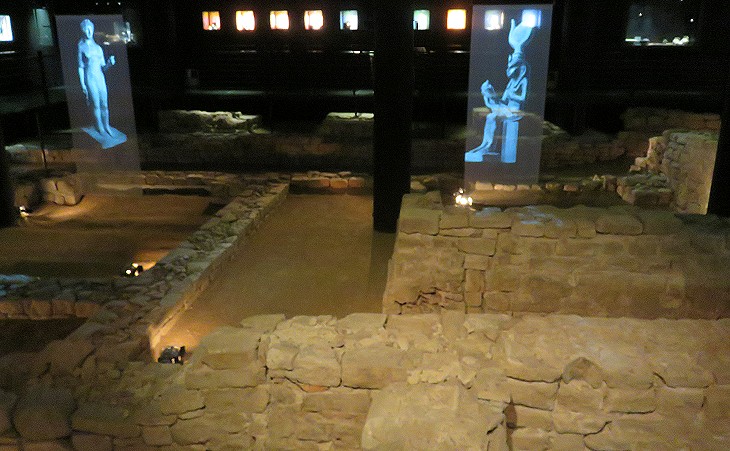
## Sanctuary of Isis and Magna Mater (Cybele)
A sanctuary was discovered by chance in 2000 when laying down the foundations of a shopping mall in the centre of the town. Similar to what occurred at Seville and other locations, the construction of the shopping mall went ahead and the ancient remains were made accessible to the public in an underground hall. It is dated late Ist century AD and it shows the spreading of oriental cults in the Rhine and Danube valleys (e.g. at Savaria). The worship of Isis became popular in Rome after the conquest of Egypt; Vespasian and Domitian were known as worshippers of the goddess. The cult of Cybele (whom the Romans called Magna Mater), an ancestral Anatolian goddess, was already shared by the Romans during the Second Punic War.

## Sanctuary of Isis and Magna Mater: almost identical votive inscriptions making reference to: (above) Mater Magna; (below) and Isis Panthea (Universal)
The cult of the two goddesses was reserved to initiates and two inscriptions found in the sanctuary suggest that they were members of an emerging class: that of former slaves who had acquired a high social status. Both inscriptions call on the goddesses to provide good to the emperors, the Senate, the People, and the Army of Rome. They were placed by Claudia and Victor when Claudius Atticus was the priest. The three were all freedmen. They were perhaps augustales, members of religious colleges of freedmen who celebrated ceremonies in honour of the Emperors. Their presence has been found in many provincial towns.
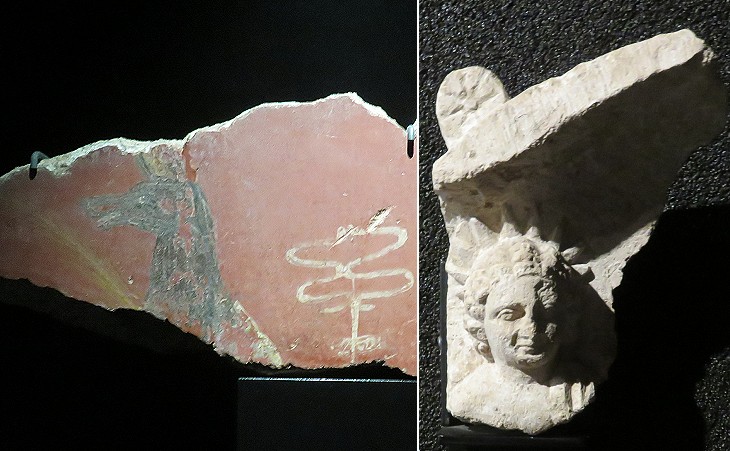
## Sanctuary of Isis and Magna Mater: (left) fresco depicting Anubis, Egyptian god of the dead, between a palm branch and a "caduceus", a symbol of Mercury meaning wealth; (right) relief portraying a sun-related deity
The identification of Anubis is out of question, whereas that of the deity crowned with solar rays is not so easy. It brings to mind reliefs from Palmyra and Pisidia, rather than Egyptian ones.
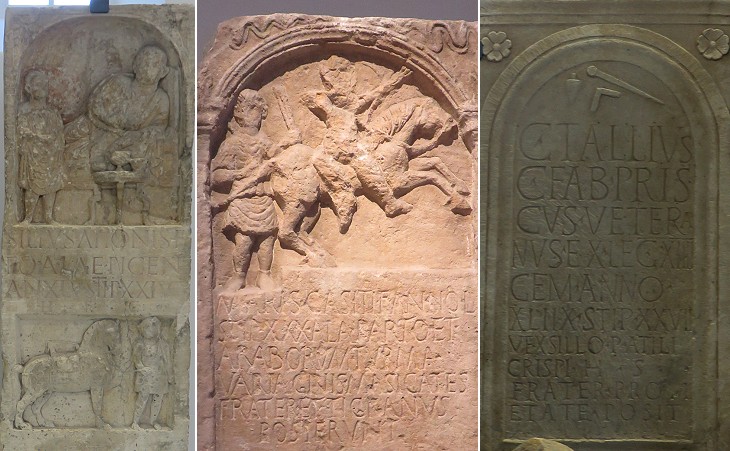
## Landesmuseum Mainz: gravestones of legionaries
Mainz has its Museum of paintings, of no great excellence, and of antiquities, curious, because for the most part found in the neighbourhood, such as Roman altars, votive tablets, and inscriptions, in which the names of the Legions stationed on this spot are commemorated. Murray The inscriptions say that: a) Silius was a cavalryman of Ala Gallorum Picentina, a regiment formed in Gaul in ca 45 and named after Lucius Rustius Picens, one of its first commanders; the regiment is mentioned also in inscriptions found at Derventio in Northern England; b) Maris was a mounted archer in a turma, a squadron which was part of a regiment of Parthians and Arabs (the former were highly reputed as archers and are depicted on Colonna Traiana); c) C. Tallius, clearly a Roman citizen, was a veteran and standard bearer of Legio XIV Gemina, and reliefs indicate that he was an engineer. These gravestones and many others show the mix of skills which made up the Roman war machine.
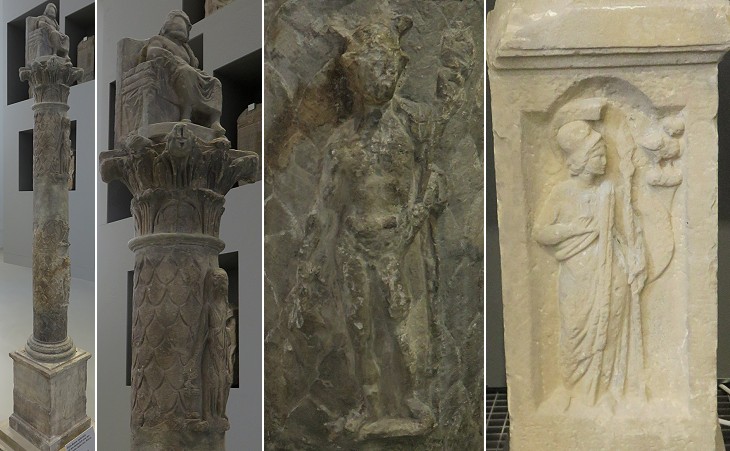
## Landesmuseum Mainz: (left) Kleine Jupitersaule (IInd century AD); (centre) Mercury on the shaft of the column; (right) altar to Minerva; the little owl is a symbol of the goddess
A column dedicated to I(ovi) O(ptimo) M(aximo), i.e. Jupiter is a monument which is typical of Roman Germany. The god is very often portrayed as a knight in the act of killing an enemy (see examples in the introductory page). In this column Jupiter sits on his throne, in line with the traditional Greek iconography. Also Mercury in the relief on the shaft and Minerva in an altar are portrayed in a traditional manner. The decoration of the column resembles tiles and it can be noticed also in other monuments of the region, e.g. Igeler Saule. Jupiter was also worshipped as Dolichenus, a variant of eastern origin. The image used as background for this page shows a relief portraying this god. Evidence of his worship can be seen also at Frankfurt and Carnuntum in Austria.
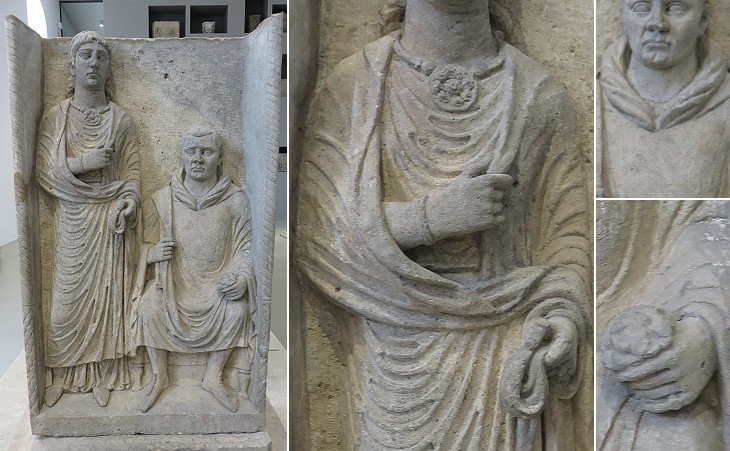
## Landesmuseum Mainz: the Weisenauer Gartner gravestone (ca 50 AD)
This stela was found in the neighbourhood of Weisenau; because the inscription is lost and the man holds a flower it is called the "Gardener of Weisenau". The couple is not portrayed in the typical posture of Roman couples, i.e. while re-enacting their wedding ceremony; to our modern eyes it rather seems a XIXth century family portrait. The couple clearly is not of Roman origin; the necklace brings to mind those which were found in Britain near St. Albans (Ashwell Hoard) in 2002; the man wears a hood (cucullus in Latin) which was typical of the Gauls. The stela is indicative of the existence of a wealthy layer of society which was not linked to the military (and of a good local sculptor). The prosperity of the civilians began to decline in the IIIrd century when the Alemanni, a confederation of German tribes, first mentioned in 213, made attempts to cross the border and occupy Agri Decumates. In 235 Emperor Alexander Severus came to Mainz to lead a campaign to stop their raids. The young emperor had no military experience and he tried to reach an agreement by buying the invaders out, thus causing the mutiny of the legions on the Rhine border. He was assassinated together with his mother and Maximinus Thrax, a local commander, was acclaimed new emperor. These events were followed by a period of military anarchy which lasted fifty years and had a major impact on Roman Germany (and on the whole Empire).

## Landesmuseum Mainz: (left) Arch of Dativius; (right) detail of the cast outside the museum
A small triumphal arch was erected during that period by Victor Dativius, decurio (magistrate) of Nida. Its fragments were found in 1891 and from the inscription we know that it was dedicated to Jupiter and to D(omus) D(ivinae), i.e. the imperial family. The arch was decorated with reliefs showing Jupiter and Juno, the Zodiac signs and scenes of sacrifices and farming activities. Its stones survived because they were used to build a new city wall in the mid of the IVth century. The arch was most likely erected to celebrate Emperor Valerian. The death of this Emperor at Bishapur in 260 prompted Postumus, the commander of the Roman legions in Germany, to proclaim himself Emperor of Gaul, Germany, Britain and Hispania. The secession was ended by Emperor Aurelian in 274, but the conflict greatly weakened the Roman army. In 278 Emperor Probus was forced to accept the controlled resettlement of Alemanni in the Agri Decumates and perhaps at Nida too. He wrote to the Senate that: Germany, throughout its whole extent, has now been subdued, and nine princes of different tribes have lain suppliant and prostrate at my feet, or, I should say, at yours. (..) The barbarians' oxen now plough the farms of Gaul, the Germans' yoked cattle, now captive, submit their necks to our husbandmen, the flocks of divers tribes are fed for the nourishing of our troops, their herds of horses are now bred for the use of our cavalry, and the grain of the barbarians fills our granaries. (Historia Augusta, a late IVth century collection of biographies of emperors and usurpers - Loeb Edition). The second part of the letter is interpreted as an admission that the Alemanni were allowed to enter the Roman territories.
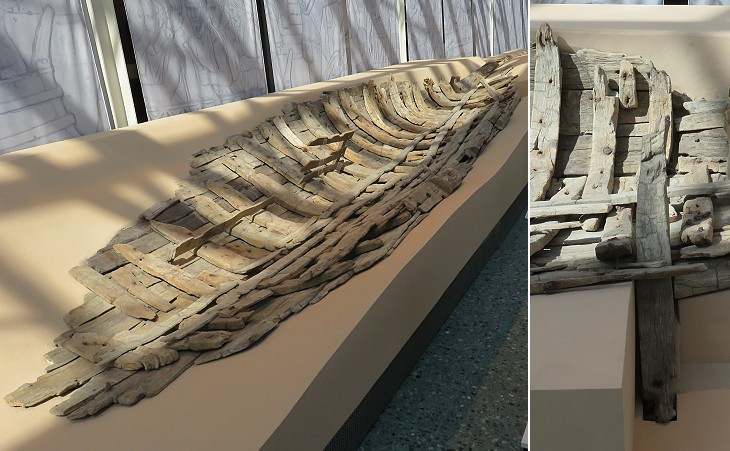
## Museum fur Antique Schiffahrt (Shipping): wreck of a Roman warship and its steering oar
In 1981 excavations led to finding six wrecks in what must have been the river harbour of Mogontiacum. They appear to have been warships and to have been made towards the end of the IIIrd century when the Alemanni took full control of the right bank of the River Rhine. A passage of Historia Augusta reports that in 280 the Roman galleys on the Rhine were burned by the Germans. In 298 Constantius Chlorus used the fleet (Classis Germanica) to drive the Alemanni out of a river island and other accounts report that also Julian and Valentinian I made use of ships to patrol the river and prevent its crossing. Eventually in the winter of 406/407, during the reign of Honorius the river froze and Vandals, Suebi and Alans were able to invade Roman Germany and eventually Gaul, Hispania and Africa. In particular the Vandals captured and sacked Mainz. In 411 the Burgundians settled at Mainz, which later on was occupied by the Franks. Its strategic position on the River Rhine ensured its survival.
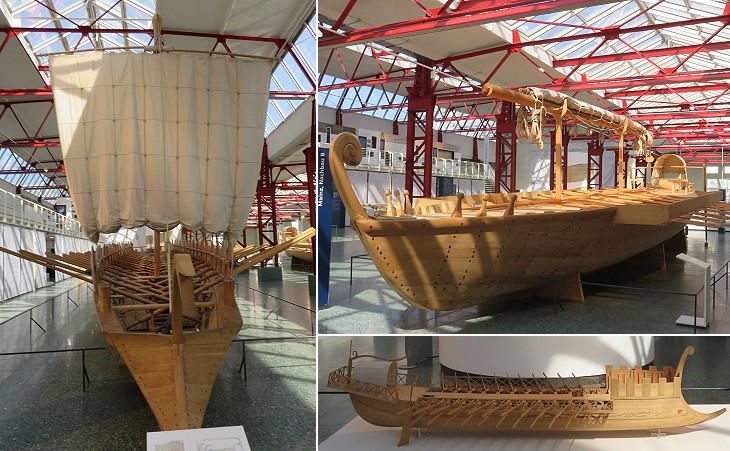
## Museum fur Antique Schiffahrt: models of warships (see a mosaic at Sousse depicting a ship which was used to patrol the coast and visit Museo delle Navi di Fiumicino to some wrecks of merchant vessels)
Move to see some other monuments of the town.